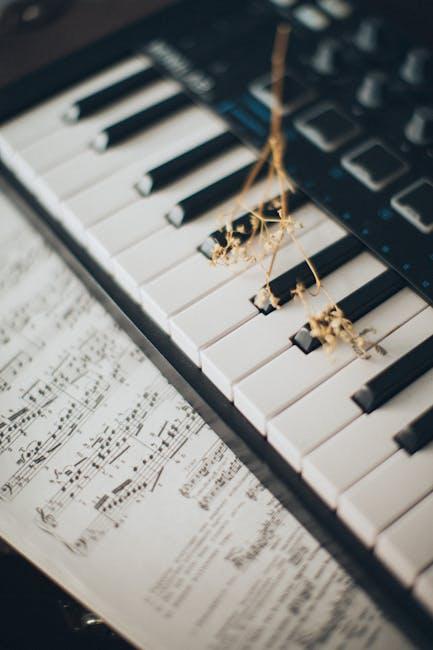Think of music theory as the secret code to unlocking the mysteries of the guitar. You know, like the Da Vinci Code, but with more chords and scales and less Tom Hanks. Understanding essential music theory concepts can take your playing from “Hot Cross Buns” to “Stairway to Heaven” faster than you can say E minor pentatonic scale. So grab your pick, strap on your guitar, and get ready to dive deep into the world of music theory for guitarists. It’s gonna be a wild ride, complete with key changes, harmonic intervals, and maybe even a few power chords thrown in for good measure. Let’s rock and roll!
Contents
- 1 Understanding Scales and Their Significance for Guitarists
- 2 Delving into Chords: Building Blocks of Guitar Music
- 3 The Role of Chord Progressions in Song Composition
- 4 Mastering Rhythmic Fundamentals for Guitar Performance
- 5 Exploring Modes: Enhancing Melodic Expression
- 6 The Importance of Arpeggios in Guitar Solos and Melodies
- 7 Incorporating Dynamics and Expression in Guitar Play
- 8 FAQs
- 9 Time to Rock On!
Understanding Scales and Their Significance for Guitarists
So you’ve picked up the guitar and you’re ready to rock out, but wait! Before you start shredding like a pro, it’s important to understand the significance of scales for guitarists.
Think of scales as the building blocks of music – they provide the foundation for creating melodies, harmonies, and solos. Without scales, your guitar playing would sound like a cat walking on a piano – not exactly music to anyone’s ears.
By mastering scales, you’ll not only improve your technique and dexterity on the guitar, but you’ll also be able to jam with other musicians more easily. Plus, knowing your scales will give you the confidence to take your playing to the next level and impress all your friends at the next BBQ.
So, grab your guitar, dust off those strings, and start practicing those scales. Trust us, your future self will thank you when you’re wowing the crowd with your epic guitar solos!

Delving into Chords: Building Blocks of Guitar Music
Ever wondered what makes a guitar sound so melodious and hypnotic? It’s all about those magical chord progressions that form the backbone of every great song. Chords are like the building blocks of a musical masterpiece, creating a harmonious blend of notes that tickle your ears and soothe your soul.
When you strum a chord on the guitar, you’re essentially playing a unique combination of notes that create a specific mood or emotion. Whether it’s the lively cheeriness of a major chord or the melancholic depth of a minor chord, each chord has its own personality that adds flavor to the music.
So how do you go about creating these magical chords on your guitar? It’s all about understanding the basic elements and experimenting with different combinations. Here are some tips to help you delve into the wonderful world of chords:
- Start by learning the basic open chords like C, G, and D. These are like the ABCs of guitar playing and will serve as your foundation.
- Experiment with barre chords to add variety and complexity to your playing. Barre chords are like the fancy spice that takes your music to the next level.
- Don’t be afraid to mix and match different chords to create unique progressions. Let your creativity run wild and see where it takes you!
The Role of Chord Progressions in Song Composition
Chord progressions are like the secret sauce of song composition – they add flavor, depth, and emotion to your music. Without them, your songs would be as bland as a saltine cracker without any toppings.
When crafting a chord progression, think of it as the musical journey your listeners are about to embark on. Will it take them on a wild rollercoaster ride of emotions, or will it gently guide them down a peaceful river of tranquility? The choice is yours, my friend.
Just like a well-seasoned chef, a skilled songwriter knows how to mix and match different chords to create the perfect harmony. Experiment with different chord progressions until you find the one that resonates with you – after all, music is all about expressing your unique voice.
So next time you sit down to write a song, don’t neglect the power of chord progressions. Embrace them, play around with them, and let them guide you on a musical journey that will leave your listeners begging for an encore.

Mastering Rhythmic Fundamentals for Guitar Performance
Ready to take your guitar performance to the next level? It’s time to dive into the rhythmic fundamentals that will set you apart from the rest of the strumming crowd.
First things first, let’s talk about that pesky metronome. Yes, it may seem like your mortal enemy at first, but trust me, it’s your best friend in disguise. Start by setting that metronome to a slow and steady tempo and practice playing along with it. Your timing will thank you later.
Next up, let’s chat about those tricky time signatures. Instead of running away screaming, embrace the challenge! Experiment with different time signatures like 7/8 or even 5/4. Who knew math could be so rock ’n’ roll?
And finally, don’t forget the power of dynamic rhythm changes. Mix it up with syncopation, accents, and silence. Your audience won’t know what hit them when you unleash a killer rhythm section full of surprises.

Exploring Modes: Enhancing Melodic Expression
So you want to enhance your melodic expression, huh? Well, you’ve come to the right place! In this section, we’re going to dive deep into the world of different modes and how they can take your melodies from basic to brilliant.
First things first, let’s talk about the good ol’ Ionian mode. This is your classic major scale, your go-to for happy, upbeat melodies. But why stop there when there are so many other modes to explore? Mix things up with the Dorian mode for a more mysterious and jazzy sound, or the Phrygian mode for a touch of exotic flair.
But wait, there’s more! Feeling a bit bluesy? Try out the Mixolydian mode for that soulful edge. And if you’re feeling extra adventurous, why not experiment with the Lydian mode for a dreamy, ethereal vibe? The possibilities are endless, my friend.
Remember, the key to truly enhancing your melodic expression is to not be afraid to step outside your comfort zone. Mix and match different modes, play around with dynamics and articulation, and most importantly, trust your instincts. So go forth, brave musician, and let your melodies soar!
The Importance of Arpeggios in Guitar Solos and Melodies
Arpeggios, those fancy-sounding cascades of notes that make everyone think you’re some guitar virtuoso, are actually pretty darn important in creating kick-ass solos and melodies. Sure, they may look intimidating at first (seriously, all those weird jumbles of fingers on the fretboard), but once you get the hang of them, they’re like your trusty sidekick in the world of guitar playing.
Think of arpeggios as the secret sauce in your musical recipe. By playing the individual notes of a chord one at a time, arpeggios add flavor, texture, and a whole lot of pizzazz to your guitar solos. They help you break out of the same old boring scale patterns and bring a whole new dimension to your playing. Plus, they sound pretty darn impressive to boot!
When you sprinkle some arpeggios into your solos and melodies, you’re not just playing notes – you’re painting a vivid sonic landscape that captures the listener’s attention and takes them on a musical journey. Whether you’re shredding a face-melting solo or serenading your significant other with a sweet melody, arpeggios can elevate your playing to a whole new level of awesomeness.
Incorporating Dynamics and Expression in Guitar Play
When it comes to adding dynamics and expression to your guitar play, it’s all about making your music come alive! Think of yourself as a musical magician, waving your guitar pick like a wand and casting spells of emotion onto your audience.
One way to incorporate dynamics into your playing is through volume control. Just like a rollercoaster, you want to take your listeners on a ride of highs and lows. Start off softly, building up to a crescendo, and then bring it back down again. This ebb and flow of volume will keep your audience on the edge of their seats, waiting to see where you’ll take them next.
Another key element of adding expression to your guitar play is through your use of techniques. Don’t be afraid to experiment with slides, bends, and vibrato to add character and personality to your sound. Remember, the guitar is your canvas, and you are the artist, painting a musical masterpiece with every note you play.
So, the next time you pick up your guitar, don’t just play the notes – feel the music, embrace the emotion, and let your inner rock star shine through. With a little practice and a lot of heart, you’ll be well on your way to becoming a guitar virtuoso!
FAQs
Why do I need to learn music theory as a guitarist?
Because without it, you’ll be strumming along aimlessly like a goat with a guitar. Music theory will give you the foundation you need to truly understand what you’re playing and take your skills to the next level.
What are some essential music theory concepts every guitarist should know?
Think of music theory as the ABCs of guitar playing. You need to know about scales, chords, intervals, and how they all fit together like puzzle pieces. It’s like learning the secret language of music!
How can understanding music theory improve my guitar playing?
Well, imagine trying to bake a cake without knowing the difference between flour and sugar. Understanding music theory will make you a more versatile and creative guitarist. You’ll be able to improvise, write your own songs, and impress all your friends at jam sessions.
Is music theory difficult to learn?
It’s not rocket science, but it does require some brain power. Just think of it as expanding your guitar-playing toolbox. The more you practice and apply these concepts, the easier it will become. Plus, it’s a great way to exercise your grey matter!
Where can I learn more about music theory for guitarists?
There are a ton of resources out there – books, online courses, YouTube tutorials, you name it! Find what works best for you and dive in. The more you learn, the more fun you’ll have shredding on your guitar like a rock god!
Time to Rock On!
Congratulations, you’ve made it through the world of essential music theory concepts for guitarists! Now that you’ve mastered these foundational elements, you’re one step closer to becoming a guitar virtuoso. So grab your guitar, crank up the amp, and rock on to your heart’s content! Remember, music theory may seem daunting at first, but with practice and patience, you’ll soon be shredding like a pro. Keep strumming and keep exploring - the world of music is yours for the taking!



